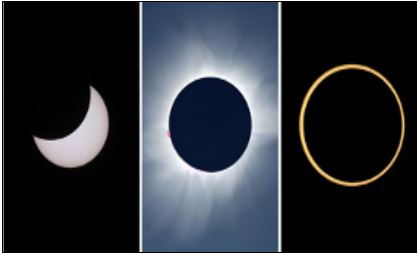By Sunil Kumar Behera
Eclipses are mesmerizing celestial events, it’s a kind of hide and seek game for celestial bodies such as our sun, moon, and the earth. There are two types of eclipses, namely solar eclipse and lunar eclipse. Again, solar eclipse is divided into subcategories.
When the moon comes in between the earth and the sun, and completely covers it, then it is called a total solar eclipse, where the apparent size of the sun and the moon are same.
If the apparent size of the moon is little less than the sun, then we see a ring of fire which is called an
annular solar eclipse. If the moon covers the sun partially, then it known as a partial solar eclipse.
Solar eclipses are very unique, and we are very lucky that we live in a perfect planet which is at a perfect distance from the sun. Our moon size, and it’s distance from the earth is such that at certain times it’s apparent size totally covers the sun, which is 400 times larger than it, but also 400 times farther . Solar eclipses are very unique, and we are very lucky that we live in a perfect planet which is at a perfect distance from the sun.
Do other planets in our solar system experience eclipses?
Uranus eclipses only occur near the equinox, there are 12 moons which are big enough to cause a solar eclipse. It occurs once in very 42 years. In Neptune, all of its six inner moon and Triton can eclipse the sun as seen from the planet. Eclipses are rare on Neptune due to the planet’s long orbital period, and large axial tilt of 28 degrees.
Even dwarf planet Pluto can eclipse the sun in a strange way. Its moon Charon is as big as the planet which shows a series of mutual eclipses. These have been observed between 1985 and 1990. The time Eclipses are mesmerizing celestial events, it’s a kind of hide and seek game for celestial bodies such as our sun, moon, and the earth. There are two types of eclipses, namely solar eclipse and lunar eclipse. Again, solar eclipse is divided into subcategories.
When the moon comes in between the earth and the sun, and completely covers it, then it is called a total solar eclipse, where the apparent size of the sun and the moon are same.
Eclipse on Mars
Yes, but in a different way, the first two inner planets, Mercury
and Venus don’t have a moon, so they never experience eclipses. The 4th planet Mars which has two moons, Deimos and Phobos. But it witnesses only one annular solar eclipse as its moons are too small and too far to cover the apparent size of the sun as seen from the planet.

Then we have the gas giant, Jupiter. The eclipse seen from Jupiter is very
unique, as it has 79 moons out of which Lo, Europa, Ganymede, and
Calisto are big enough to cause solar eclipses. We can see a triple eclipse on Jupiter once in every 10 years.
Saturn holds the highest number of moons in our solar system i.e. 82 moons. There are 7 moons which are big enough to cause a total solar
eclipse, but it happens once in every 15 years because of its tilted orbital plane.

Uranus eclipses only occur near the equinox, there are 12 moons which are big enough to cause a solar eclipse. It occurs once in very 42 years. In Neptune, all of its six inner moon and Triton can eclipse the sun as seen from the planet. Eclipses are rare on Neptune due to the planet’s long orbital period, and large axial tilt of 28 degrees.
Even dwarf planet Pluto can eclipse the sun in a strange way. Its moon Charon is as big as the planet which shows a series of mutual eclipses. These have been observed between 1985 and 1990. The time duration of these mutual eclipses is about 6.4 Earth days. But because Pluto only shows one side of its face to Charon, solar eclipses only happen on that half of the planet.
If you are excited to see a solar eclipse, then this is the best time. Grab your solar filters or make you own DIY pin hole projector to see solar eclipse safely which is going to occur on the 21st June 2020. Enjoy the last solar eclipse by following social distancing and safety precautions!

